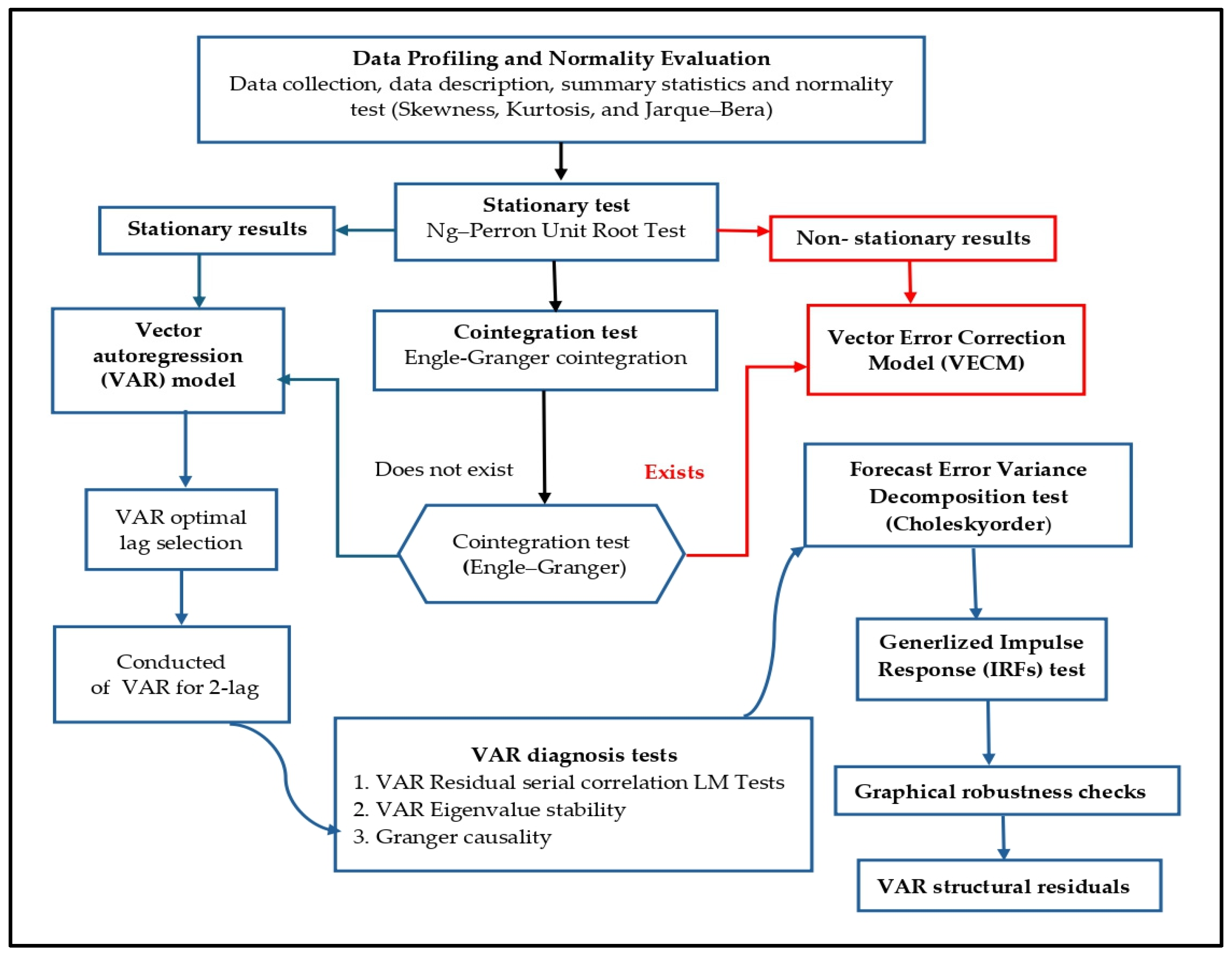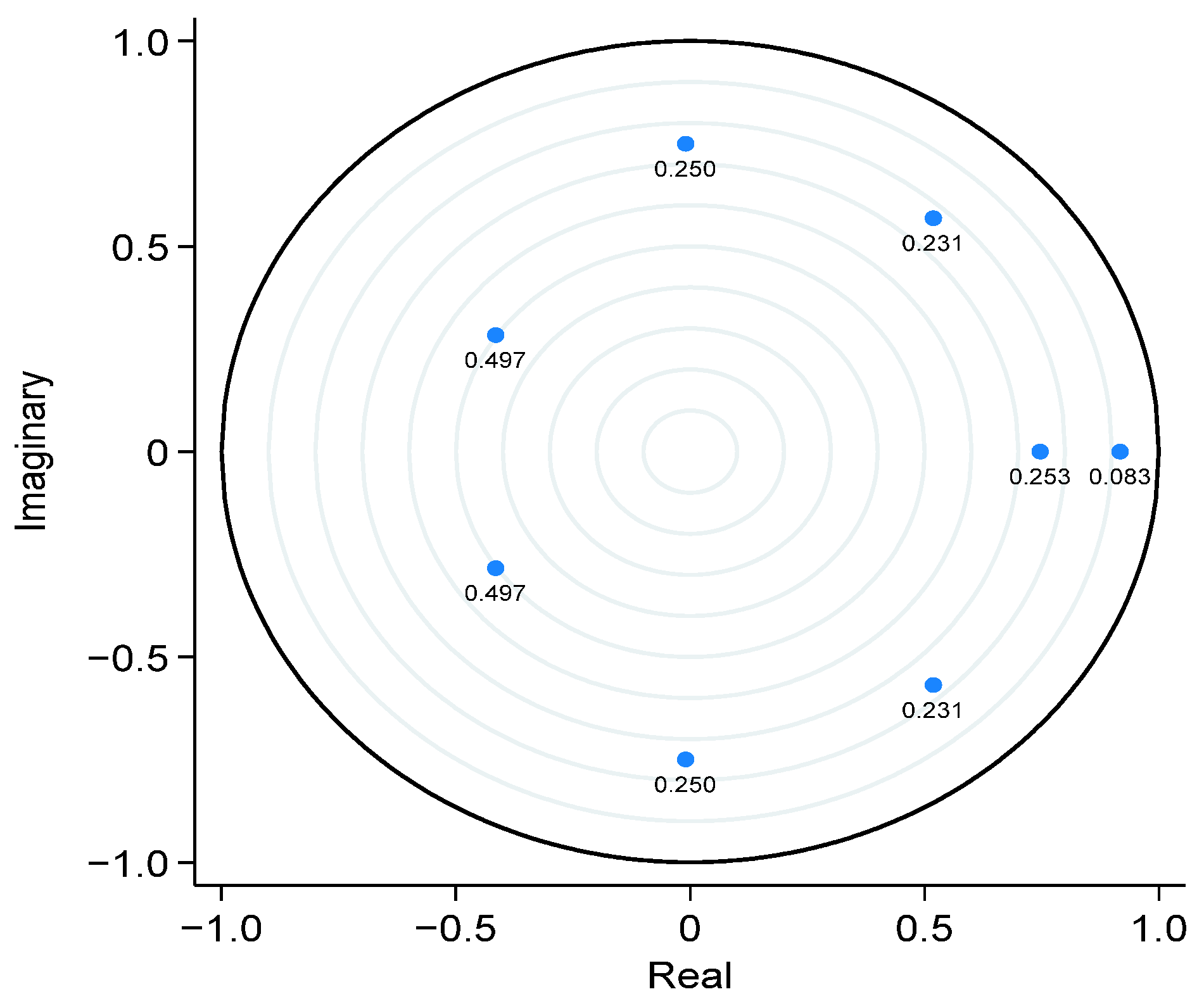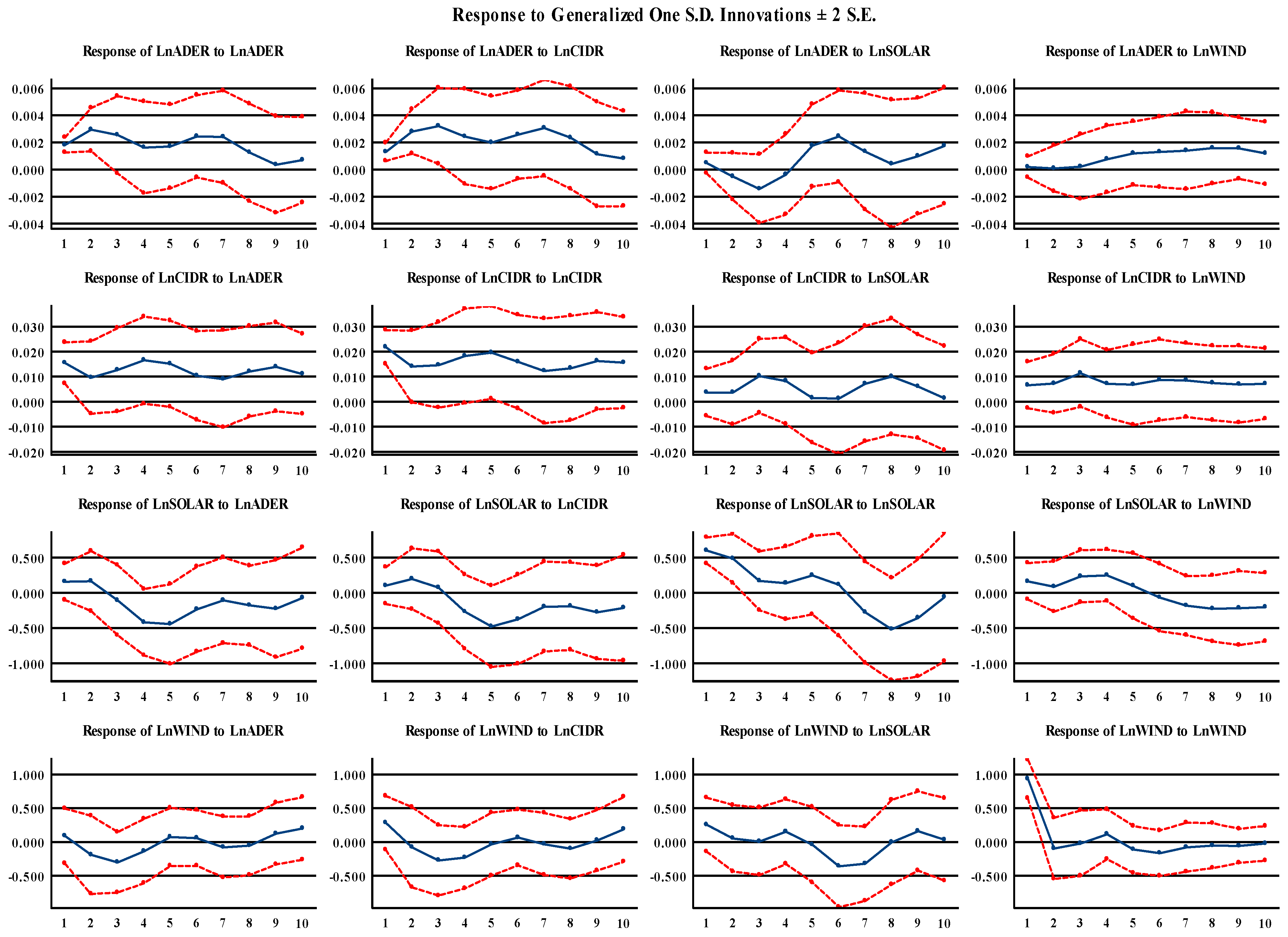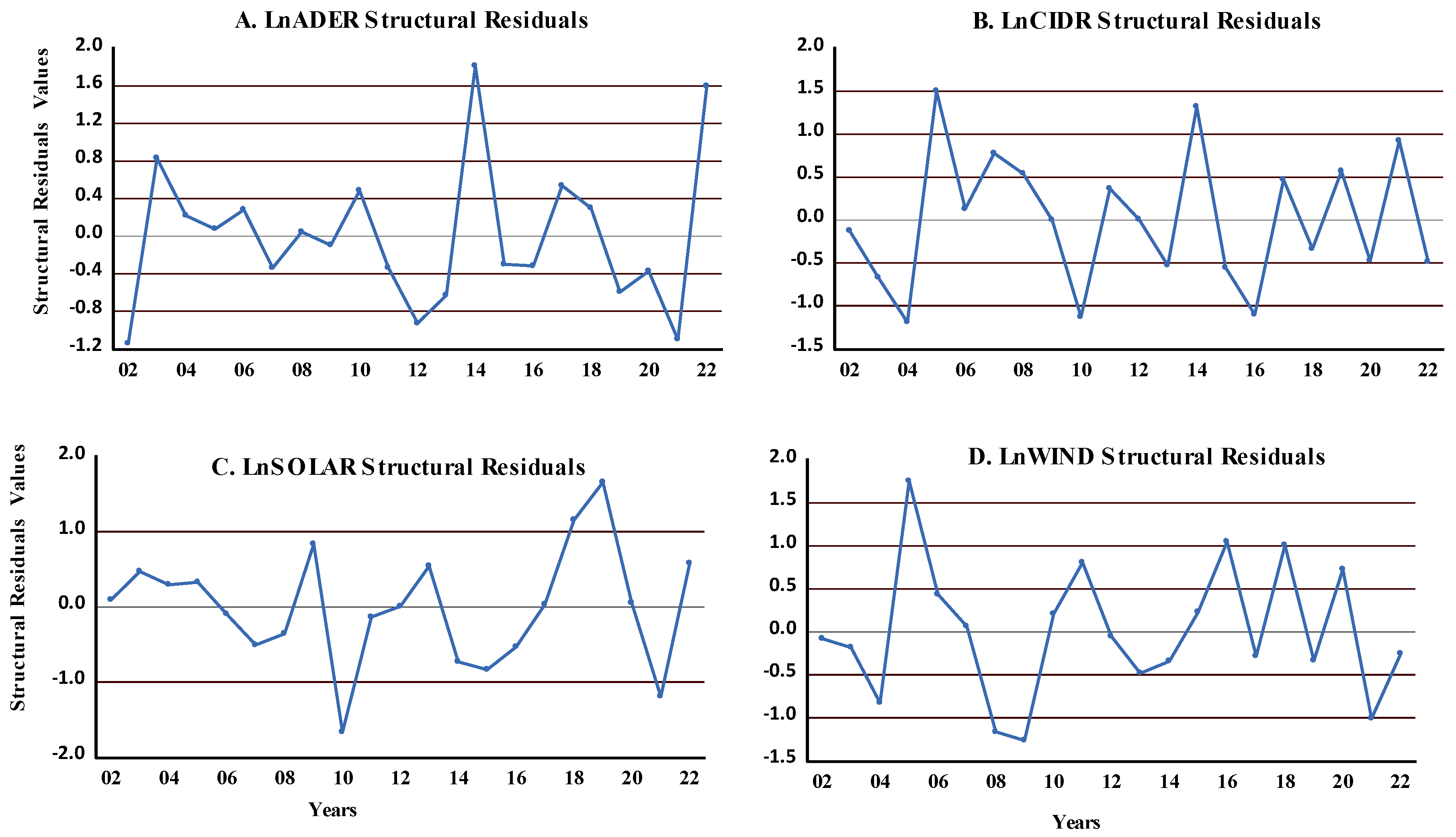Food Security–Renewable Energy Nexus: Innovations and Shocks in Saudi Arabia
Abstract
1. Introduction
2. Methodology and Empirical Approach
2.1. Data
2.2. Econometrics Model
2.2.1. Unit-Root Test
2.2.2. Basic VAR System
2.3. Robust Analysis Checks
2.3.1. Impulse Response Functions
2.3.2. Forecast-Error Variance Decompositions
3. Results
3.1. Unit Root Result
3.2. Lag-Order Selection Criteria
3.3. VAR Results
3.4. VAR Diagnosis Analysis
3.5. Granger Causality Results
3.6. Forecast Error Variance Decomposition for Food Security and Renewable Energy Consumption
3.7. Graphical Robustness Checks
4. Discussion
5. Conclusions
6. Policy Implications and Limitations
Author Contributions
Funding
Institutional Review Board Statement
Informed Consent Statement
Data Availability Statement
Conflicts of Interest
References
- Ramakrishnan, P.S. Increasing Population and Declining Biological Resources in the Context of Global Change and Globalization. J. Biosci. 2001, 26, 465–479. [Google Scholar] [CrossRef] [PubMed]
- Ivanovski, K.; Hailemariam, A.; Smyth, R. The Effect of Renewable and Non-Renewable Energy Consumption on Economic Growth: Non-Parametric Evidence. J. Clean. Prod. 2021, 286, 124956. [Google Scholar] [CrossRef]
- Khan, S.A.R.; Zia-Ul-Haq, H.M.; Ponce, P.; Janjua, L. Re-Investigating the Impact of Non-Renewable and Renewable Energy on Environmental Quality: A Roadmap towards Sustainable Development. Resour. Policy 2023, 81, 103411. [Google Scholar] [CrossRef]
- Gorjian, S.; Ebadi, H.; Jathar, L.D.; Savoldi, L. Solar Energy for Sustainable Food and Agriculture: Developments, Barriers, and Policies. In Solar Energy Advancements in Agriculture and Food Production Systems; Elsevier: Amsterdam, The Netherlands, 2022; pp. 1–28. [Google Scholar]
- Ogbolumani, O.A.; Nwulu, N.I. A Food-Energy-Water Nexus Meta-Model for Food and Energy Security. Sustain. Prod. Consum. 2022, 30, 438–453. [Google Scholar] [CrossRef]
- García-Díez, J.; Gonçalves, C.; Grispoldi, L.; Cenci-Goga, B.; Saraiva, C. Determining Food Stability to Achieve Food Security. Sustainability 2021, 13, 7222. [Google Scholar] [CrossRef]
- Zhuang, D.; Abbas, J.; Al-Sulaiti, K.; Fahlevi, M.; Aljuaid, M.; Saniuk, S. Land-Use and Food Security in Energy Transition: Role of Food Supply. Front. Sustain. Food Syst. 2022, 6, 1053031. [Google Scholar] [CrossRef]
- Hache, E. Do Renewable Energies Improve Energy Security in the Long Run? Int. Econ. 2018, 156, 127–135. [Google Scholar] [CrossRef]
- Razmjoo, A.; Ghazanfari, A.; Østergaard, P.A.; Jahangiri, M.; Sumper, A.; Ahmadzadeh, S.; Eslamipoor, R. Moving Toward the Expansion of Energy Storage Systems in Renewable Energy Systems—A Techno-Institutional Investigation with Artificial Intelligence Consideration. Sustainability 2024, 16, 9926. [Google Scholar] [CrossRef]
- Abbasi, K.R.; Shahbaz, M.; Zhang, J.; Irfan, M.; Alvarado, R. Analyze the Environmental Sustainability Factors of China: The Role of Fossil Fuel Energy and Renewable Energy. Renew. Energy 2022, 187, 390–402. [Google Scholar] [CrossRef]
- Zafar, M.W.; Shahbaz, M.; Sinha, A.; Sengupta, T.; Qin, Q. How Renewable Energy Consumption Contribute to Environmental Quality? The Role of Education in OECD Countries. J. Clean. Prod. 2020, 268, 122149. [Google Scholar] [CrossRef]
- Wennersten, R.; Qie, S. United Nations Sustainable Development Goals for 2030 and Resource Use. In Handbook of Sustainability Science and Research; Springer: Cham, Switzerland, 2018; pp. 317–339. [Google Scholar]
- Miao, Y.; Razzaq, A.; Adebayo, T.S.; Awosusi, A.A. Do Renewable Energy Consumption and Financial Globalisation Contribute to Ecological Sustainability in Newly Industrialized Countries? Renew. Energy 2022, 187, 688–697. [Google Scholar] [CrossRef]
- Neupane, N.; Chaudhary, P.; Rijal, Y.; Ghimire, B.; Bhandari, R. The Role of Renewable Energy in Achieving Water, Energy, and Food Security under Climate Change Constraints in South Asia. Front. Sustain. Food Syst. 2022, 6, 1016093. [Google Scholar] [CrossRef]
- Saudi Arabia’s Vision 2030. National Transformation Program. 2020. Available online: https://www.vision2030.gov.sa/en (accessed on 1 April 2025).
- IEA. World Energy Outlook 2021—Analysis. Available online: https://www.iea.org/reports/world-energy-outlook-2021 (accessed on 1 April 2025).
- Bazgă, B. Food Security Component of Sustainable Development—Prospects and Challenges in the Next Decade. Procedia Econ. Financ. 2015, 32, 1075–1082. [Google Scholar] [CrossRef]
- Amran, Y.H.A.; Amran, Y.H.M.; Alyousef, R.; Alabduljabbar, H. Renewable and Sustainable Energy Production in Saudi Arabia According to Saudi Vision 2030; Current Status and Future Prospects. J. Clean. Prod. 2020, 247, 119602. [Google Scholar] [CrossRef]
- Aslan, A.; Ocal, O.; Ozsolak, B.; Ozturk, I. Renewable Energy and Economic Growth Relationship under the Oil Reserve Ownership: Evidence from Panel VAR Approach. Renew. Energy 2022, 188, 402–410. [Google Scholar] [CrossRef]
- Elzaki, R.M.; Al-Mahish, M. Food Insecurity and Water Management Shocks in Saudi Arabia: Bayesian VAR Analysis. PLoS ONE 2024, 19, e0296721. [Google Scholar] [CrossRef]
- Li, H.; Zhou, X.; Tang, M.; Guo, L. Impact of Population Aging and Renewable Energy Consumption on Agricultural Green Total Factor Productivity in Rural China: Evidence from Panel VAR Approach. Agriculture 2022, 12, 715. [Google Scholar] [CrossRef]
- de Paula Leite, A.C.; Pimentel, L.M.; de Almeida Monteiro, L. Impact of Agricultural and Energy Prices on the Biofuels Market through a VAR-VEC Model. Renew. Energy 2024, 232, 121130. [Google Scholar] [CrossRef]
- Rehman, A.; Batool, Z.; Ma, H.; Alvarado, R.; Oláh, J. Climate Change and Food Security in South Asia: The Importance of Renewable Energy and Agricultural Credit. Humanit. Soc. Sci. Commun. 2024, 11, 342. [Google Scholar] [CrossRef]
- Abu-Rayash, A.; Dincer, I. Development and Assessment of an Integrated Wind-Solar Based Energy System for Sustainable Communities. Energy Convers. Manag. 2023, 277, 116680. [Google Scholar] [CrossRef]
- Rahman, M.M.; Khan, I.; Field, D.L.; Techato, K.; Alameh, K. Powering Agriculture: Present Status, Future Potential, and Challenges of Renewable Energy Applications. Renew. Energy 2022, 188, 731–749. [Google Scholar] [CrossRef]
- Strezov, V.; Anawar, H.M. (Eds.) Renewable Energy Systems from Biomass; CRC Press: Boca Raton, FL, USA; Taylor & Francis: Oxfordshire, UK, 2018; ISBN 9781315153971. [Google Scholar]
- Mercure, J.-F.; Paim, M.A.; Bocquillon, P.; Lindner, S.; Salas, P.; Martinelli, P.; Berchin, I.I.; de Andrade Guerra, J.B.S.O.; Derani, C.; de Albuquerque Junior, C.L.; et al. System Complexity and Policy Integration Challenges: The Brazilian Energy-Water-Food Nexus. Renew. Sustain. Energy Rev. 2019, 105, 230–243. [Google Scholar] [CrossRef]
- Burney, J.A.; Naylor, R.L.; Postel, S.L. The Case for Distributed Irrigation as a Development Priority in Sub-Saharan Africa. Proc. Natl. Acad. Sci. USA 2013, 110, 12513–12517. [Google Scholar] [CrossRef]
- Eslamipoor, R. A New Heuristic Approach for a Multi-Depot Three-Level Location-Routing-Inventory Problem. Int. J. Manag. Concepts Philos. 2024, 17, 322–339. [Google Scholar] [CrossRef]
- El Baz, J.; Jebli, F.; Gissel, A.; Gourdin, K. Harnessing Interestingness in Supply Chain Management Research: An Empirical Investigation and Research Agenda. Benchmarking Int. J. 2024, 31, 3782–3806. [Google Scholar] [CrossRef]
- Eslamipoor, R. Contractual Mechanisms for Coordinating a Sustainable Supply Chain with Carbon Emission Reduction. Bus. Strategy Environ. 2025; early view. [Google Scholar] [CrossRef]
- He, J.; Osabohien, R.; Yin, W.; Adeleke, O.K.; Uduma, K.; Agene, D.; Su, F. Green Economic Growth, Renewable Energy and Food Security in Sub-Saharan Africa. Energy Strategy Rev. 2024, 55, 101503. [Google Scholar] [CrossRef]
- Çakmakçı, R.; Salık, M.A.; Çakmakçı, S. Assessment and Principles of Environmentally Sustainable Food and Agriculture Systems. Agriculture 2023, 13, 1073. [Google Scholar] [CrossRef]
- Łącka, I.; Suproń, B.; Szczepaniak, I. Does Climate Change and Energy Consumption Affect the Food Security of European Union Countries? Empirical Evidence from a Panel Study. Energies 2024, 17, 3237. [Google Scholar] [CrossRef]
- Wang, Y.; Ahmed, M.; Raza, S.A.; Ahmed, M. Threshold Nonlinear Relationship between Renewable Energy Consumption and Agriculture Productivity: The Role of Foreign Direct Investment and Financial Inclusion. Environ. Sci. Pollut. Res. 2023, 30, 65900–65915. [Google Scholar] [CrossRef]
- Dehbidi, N.K.; Zibaei, M.; Tarazkar, M.H. The Effect of Climate Change and Energy Shocks on Food Security in Iran’s Provinces. Reg. Sci. Policy Pract. 2022, 14, 417–438. [Google Scholar] [CrossRef]
- Derouez, F.; Ifa, A. Sustainable Food Security: Balancing Desalination, Climate Change, and Population Growth in Five Arab Countries Using ARDL and VECM. Sustainability 2024, 16, 2302. [Google Scholar] [CrossRef]
- Kumar, C.M.S.; Singh, S.; Gupta, M.K.; Nimdeo, Y.M.; Raushan, R.; Deorankar, A.V.; Kumar, T.M.A.; Rout, P.K.; Chanotiya, C.S.; Pakhale, V.D.; et al. Solar Energy: A Promising Renewable Source for Meeting Energy Demand in Indian Agriculture Applications. Sustain. Energy Technol. Assess. 2023, 55, 102905. [Google Scholar] [CrossRef]
- Negera, M.; Dejen, Z.A.; Melaku, D.; Tegegne, D.; Adamseged, M.E.; Haileslassie, A. Agricultural Productivity of Solar Pump and Water Harvesting Irrigation Technologies and Their Impacts on Smallholder Farmers’ Income and Food Security: Evidence from Ethiopia. Sustainability 2025, 17, 1486. [Google Scholar] [CrossRef]
- Rana, M.S.; Rahman, A.N.M.A.; Ahmed, R.; Hossain, M.P.; Shadman, M.S.; Majumdar, P.K.; Islam, K.S.; Colton, J. Design, Fabrication, and Performance Evaluation of a Food Solar Dryer. AgriEngineering 2024, 6, 4506–4523. [Google Scholar] [CrossRef]
- Nakata, H.; Ogata, S. Geographic Information System-Based Analysis of Reclaimable Idle Cropland for Agrivoltaics in Kansai, Japan: Enhancing Energy and Food Security. Agronomy 2024, 14, 398. [Google Scholar] [CrossRef]
- Zakari, A.; Toplak, J.; Tomažič, L.M. Exploring the Relationship between Energy and Food Security in Africa with Instrumental Variables Analysis. Energies 2022, 15, 5473. [Google Scholar] [CrossRef]
- FAO. Suite of Food Security Indicators. Available online: https://www.fao.org/faostat/en/#data/FS (accessed on 1 April 2025).
- Our World in Data Energy. Available online: https://ourworldindata.org/energy (accessed on 1 April 2025).
- Sims, C. Comparison of Interwar and Postwar Business Cycles: Monetarism Reconsidered; American Economic Association: Cambridge, MA, USA, 1980. [Google Scholar]
- Ng, S.; Perron, P. LAG Length Selection and the Construction of Unit Root Tests with Good Size and Power. Econometrica 2001, 69, 1519–1554. [Google Scholar] [CrossRef]
- Mohamed, A.A.; Nageye, A.I. Measuring the Effect of Land Degradation and Environmental Changes on Agricultural Production in Somalia with Two Structural Breaks. Manag. Environ. Qual. Int. J. 2020, 32, 160–174. [Google Scholar] [CrossRef]
- Phillips, P.C.B. Time Series Regression with a Unit Root. Econometrica 1987, 55, 277. [Google Scholar] [CrossRef]
- Phillips, P.C.B.; Perron, P. Testing for a Unit Root in Time Series Regression. Biometrika 1988, 75, 335–346. [Google Scholar] [CrossRef]
- Koutlis, C.; Papadopoulos, S.; Schinas, M.; Kompatsiaris, I. LAVARNET: Neural Network Modeling of Causal Variable Relationships for Multivariate Time Series Forecasting. Appl. Soft Comput. 2020, 96, 106685. [Google Scholar] [CrossRef]
- Lopreite, M.; Zhu, Z. The Effects of Ageing Population on Health Expenditure and Economic Growth in China: A Bayesian-VAR Approach. Soc. Sci. Med. 2020, 265, 113513. [Google Scholar] [CrossRef]
- Foabeh, P.A.; Aumeboonsuke, V. Resilience of Developing Economies to External Shocks: Empirical Evidence from CEMAC Countries. J. Adv. Manag. Res. 2025, 22, 72–89. [Google Scholar] [CrossRef]
- Swanson, N.R.; Granger, C.W.J. Impulse Response Functions Based on a Causal Approach to Residual Orthogonalization in Vector Autoregressions. J. Am. Stat. Assoc. 1997, 92, 357–367. [Google Scholar] [CrossRef]
- Samour, A.; Musah, M.; Mati, S.; Amri, F. Testing the Impact of Environmental Taxation and IFRS Adoption on Consumption-based Carbon in European Countries. Environ. Sci. Pollut. Res. 2024, 31, 34896–34909. [Google Scholar] [CrossRef]
- Sheferaw, H.E.; Sitotaw, K.W. Empirical Investigation of Exchange Rate Transmission into General Inflation Level in Ethiopia—SVAR Approach. Cogent Bus. Manag. 2023, 10, 2243662. [Google Scholar] [CrossRef]
- Uddin, M.J. Investigating the Impulse Responses of Renewable Energy in the Context of China: A Bayesian VAR Approach. Renew. Energy 2023, 219, 119485. [Google Scholar] [CrossRef]
- Liu, X.; Wang, B.; Luo, M.; Liu, Y. The Dynamic Risk Spillover of Higher-Order Moments in the China’s Energy Market: A Time-Frequency Perspective. Int. J. Green Energy 2024, 1–19. [Google Scholar] [CrossRef]
- MacKinnon, J.G. Numerical Distribution Functions for Unit Root and Cointegration Tests. J. Appl. Econom. 1996, 11, 601–618. Available online: http://www.jstor.org/stable/2285154 (accessed on 1 April 2025).
- Chen, S.-S.; Lin, T.-Y. Monetary Policy and Renewable Energy Production. Energy Econ. 2024, 132, 107495. [Google Scholar] [CrossRef]
- Vo, L.H.; Le, T.-H. Eatery, Energy, Environment and Economic System, 1970–2017: Understanding Volatility Spillover Patterns in a Global Sample. Energy Econ. 2021, 100, 105391. [Google Scholar] [CrossRef]
- Singh, A.K.; Poonia, S.; Santra, P.; Jain, D. Ensuring Energy and Food Security Through Solar Energy Utilization. In Contemporary Environmental Issues and Challenges in Era of Climate Change; Springer: Singapore, 2020; pp. 199–218. [Google Scholar]
- Al-Saidi, M.; Elagib, N.A. Ecological Modernization and Responses for a Low-carbon Future in the Gulf Cooperation Council Countries. WIREs Clim. Change 2018, 9, e528. [Google Scholar] [CrossRef]
- Bathaei, A.; Štreimikienė, D. Renewable Energy and Sustainable Agriculture: Review of Indicators. Sustainability 2023, 15, 14307. [Google Scholar] [CrossRef]
- Almasri, R.A.; Narayan, S. A Recent Review of Energy Efficiency and Renewable Energy in the Gulf Cooperation Council (GCC) Region. Int. J. Green Energy 2021, 18, 1441–1468. [Google Scholar] [CrossRef]
- Lawal, A.I. The Nexus between Economic Growth, Energy Consumption, Agricultural Output, and CO2 in Africa: Evidence from Frequency Domain Estimates. Energies 2023, 16, 1239. [Google Scholar] [CrossRef]
- Zhang, X.; Wang, X.; Si, D.; Zhang, H.; Ageli, M.M.; Mentel, G. Natural Resources, Food, Energy and Water: Structural Shocks, Food Production and Clean Energy for USA in the View of COP27. Land Degrad. Dev. 2024, 35, 2602–2613. [Google Scholar] [CrossRef]
- Alola, A.A. The Nexus of Renewable Energy Equity and Agricultural Commodities in the United States: Evidence of Regime-Switching and Price Bubbles. Energy 2022, 239, 122377. [Google Scholar] [CrossRef]
- Mujtaba, I.M.; Srinivasan, R.; Elbashir, N.O. The Water-Food-Energy Nexus; CRC Press: Boca Raton, FL, USA, 2017; ISBN 9781315153209. [Google Scholar]




| Statistic Term | ADER | CIDR | SOLAR | WIND |
|---|---|---|---|---|
| Mean | 2380.478 | 86.870 | 2.061 | 2.706 |
| Median | 2398.000 | 88.000 | 0.332 | 0.752 |
| Maximum | 2424.000 | 103.600 | 10.807 | 11.768 |
| Minimum | 2312.000 | 69.900 | −0.571 | −0.650 |
| Std. Dev. | 37.822 | 10.430 | 3.018 | 3.603 |
| Skewness | −0.633 | −0.111 | 1.413 | 1.369 |
| Kurtosis | 1.910 | 1.888 | 4.205 | 3.626 |
| Jarque–Bera | 2.675 | 1.233 | 9.044 | 7.558 |
| Probability | 0.263 | 0.540 | 0.011 | 0.023 |
| Sum | 54,751.000 | 1998.000 | 47.402 | 62.236 |
| Sum Sq. Dev. | 31,471.740 | 2393.249 | 200.334 | 285.553 |
| Observations | 23 | 23 | 23 | 23 |
| Ng–Perron Test Statistics (Intercept Model) at a Level | Ng–Perron Test Statistics (Intercept Model) at First Difference | |||||||
|---|---|---|---|---|---|---|---|---|
| Test Variable | MZa | MZt | MSB | MPT | MZa | MZt | MSB | MPT |
| LnADER | −2.742 | −0.913 | 0.333 | 8.059 | −55.705 | −4.988 | 0.090 | 1.105 |
| LnCIDR | −13.717 | −2.481 | 0.181 | 2.288 | −16.713 | −2.890 | 0.173 | 1.470 |
| LnSOLAR | −4.990 | −1.448 | 0.290 | 5.194 | −11.945 | −2.197 | 0.184 | 2.939 |
| LnWIND | −10.801 | −2.302 | 0.213 | 2.350 | −7.948 | −1.962 | 0.247 | 3.194 |
| Endogenous Variables | Tau-Statistic | a p-Values | Z-Statistic | p-Values |
|---|---|---|---|---|
| LnADER | −4.493 | 0.063 | −17.99193 | 0.1599 |
| LnCIDR | −3.397 | 0.304 | −13.56217 | 0.4227 |
| LnSOLAR | −2.701 | 0.603 | −11.29017 | 0.5981 |
| LnWIND | −4.801 | 0.038 *** | −22.93033 | 0.033 *** |
| Intermediate Results | ||||
| Tests | LnADER | LnCIDR | LnSOLAR | LnWIND |
| b Rho (ρ) (rho) − 1 | −0.818 | −0.616 | −0.5132 | −1.0423 |
| c Rho (ρ) S.E. | 0.182 | 0.1814 | 0.1899 | 0.217 |
| Residual variance | 8.82 × 10−6 | 0.0006 | 0.5198 | 0.705 |
| Long-run residual variance | 8.82 × 10−6 | 0.0006 | 0.5198 | 0.705 |
| ** Number of stochastic trends | 4 | 4 | 4 | 4 |
| Estimation Lag Order Statistics | ||||||||
|---|---|---|---|---|---|---|---|---|
| Lag | LogL | LR | FPE | AIC | HQIC | SBIC | df | p-Value |
| 0 | 7.669 | 9.2e | 8.00 | −4.852 | −4.825 | |||
| 1 | 118.367 | 141.4 | 2.2 × 10−10 | −10.930 | −10.793 | −9.940 | 16 | 0.00 |
| 2 | 153.247 | 69.759 * | 3.8 × 10−11 * | −13.027 * | −12.782 * | −11.247 * | 16 | 0.00 |
| Independent Variables (Exogenous) | Dependent Variables (Endogenous) | |||
|---|---|---|---|---|
| LnADER | LnCIDR | LnSOLAR | LnWIND | |
| LnADER(−1) | 1.054 (0.141) [7.468] *** | 1.756 (0.317) [5.549] *** | −2.183 (0.302) [−7.239] *** | 0.036 (0.183) [0.198] |
| LnADER(−2) | −0.521 (0.133) [−3.922] *** | 0.291 (0.341) [0.852] | −0.373 (0.516) [−0.723] | 0.484 (0.207) [2.341] |
| LnCIDR(−1) | 0.042 (0.109) [0.388] | 0.759 (0.244) [3.105] *** | 0.026 (0.233) [0.110] | −0.057 (0.141) [−0.404] |
| LnCIDR(−2) | 0.005 (0.103) [0.044] | 0.051 (0.263) [0.193] | 0.206 (0.399) [0.517] | −0.108 (0.160) [−0.679] |
| LnSOLAR(−1) | −0.194 (0.090) [−2.157] ** | 0.376 (0.201) [1.867] ** | 0.516 (0.192) [2.690] ** | 0.196 (0.116) [1.691] * |
| LnSOLAR(−2) | 0.069 (0.084) [0.817] | 0.365 (0.217) [1.682] * | −1.285 (0.328) [−3.914] *** | 0.238 (0.131) [1.812] |
| LnWIND(−1) | −0.237 (0.166) [−1.424] | 0.184 (0.373) [0.493] | −0.044 (0.355) [−0.125] | −0.143 (0.215) [−0.665] |
| LnWIND(−2) | 0.316 (0.157) [2.017] ** | −0.394 (0.402) [−0.980] | 0.002 (0.609) [0.004] | 0.509 (0.244) [2.090] ** |
| Constant | 941.480 (184.138) [5.113] *** | −93.074 (142.190) [−0.655] | 236.151 (117.098) [2.017] ** | −166.250 (217.048) [−0.766] |
| RMSFE | 0.000813 | 0.025469 | 0.426824 | 1.21787 |
| R-squared | 0.996 | 0.9730 | 0.9864 | 0.760 |
| Chi2 | 11,667.92 *** | 647.7489 *** | 1303.26 | 57.09254 |
| Log-likelihood | 153.2501 | |||
| FPE | 3.83 × 10−11 | |||
| Det (Sigma_ml) | 4.73 × 10−13 | |||
| AIC | −24.82375 | |||
| HQIC | −24.60549 | |||
| SBIC | −23.24086 | |||
| Null hypothesis: No serial correlation at lag h | ||||||
| Lag | LRE * stat | df | p-value | Rao F-stat | df | p-value |
| 1 | 11.99049 | 16 | 0.7446 | 0.683857 | (16, 15.9) | 0.7720 |
| 2 | 16.73130 | 16 | 0.4032 | 1.069668 | (16, 15.9) | 0.4475 |
| Null hypothesis: No serial correlation at lags 1 to h | ||||||
| Lag | LRE * stat | df | p-value | Rao F-stat | df | Prob. |
| 1 | 11.99049 | 16 | 0.7446 | 0.683857 | (16, 15.9) | 0.7720 |
| 2 | 45.69779 | 32 | 0.0552 | 1.405993 | (32, 5.3) | 0.3734 |
| Root | Modulus |
|---|---|
| 0.225244 − 0.939224i | 0.965855 |
| 0.225244 + 0.939224i | 0.965855 |
| 0.961982 | 0.961982 |
| 0.781949 − 0.448352i | 0.901368 |
| 0.781949 + 0.448352i | 0.901368 |
| −0.169970 − 0.528043i | 0.554724 |
| −0.169970 + 0.528043i | 0.554724 |
| −0.138230 | 0.138230 |
| Excluded | chi2 | Prob > chi2 | The Results of Causality Run | Direction | |
|---|---|---|---|---|---|
| LnADER | LnCIDR | 150.100 | 0.00 *** | CIDR → ADER | Unidirectional |
| LnSOLAR | 52.770 | 0.00 *** | Solar ←→ ADER | Bidirectional | |
| LnWIND | 0.848 | 0.65 | No causality | Individuality | |
| ALL | 319.330 | 0.00 *** | REC ←→ ADER | Bidirectional | |
| LnCIDR | LnADER | 0.893 | 0.64 | No causality | Individuality |
| LnSOLAR | 1.388 | 0.50 | No causality | Individuality | |
| LnWIND | 0.9188 | 0.63 | No causality | Individuality | |
| ALL | 4.763 | 0.58 | No causality | Individuality | |
| LnSolar | LnADER | 18.457 | 0.00 *** | ADER ←→ Solar | Bidirectional |
| LnCIDR | 0.600 | 0.74 | No causality | Individuality | |
| LnWIND | 1.499 | 0.47 | No causality | Individuality | |
| ALL | 65.480 | 0.00 *** | FS ←→ Solar | Bidirectional | |
| Lnwind | LnADER | 2.307 | 0.32 | No causality | Individuality |
| LnCIDR | 2.337 | 0.31 | No causality | Individuality | |
| LnSOLAR | 6.615 | 0.04 * | Solar → Wind | Unidirectional | |
| ALL | 27.962 | 0.00 *** | FS ←→ Wind | Bidirectional |
| Period | FEVD for LnADER | FEVD for LnCIDR | ||||||
|---|---|---|---|---|---|---|---|---|
| LnADER | LnCIDR | LnSOLAR | LnWIND | LnADER | LnCIDR | LnSOLAR | LnWIND | |
| 1 | 100.000 | 0.000 | 0.000 | 0.000 | 50.452 | 49.548 | 0.000 | 0.000 |
| 2 | 80.955 | 6.919 | 11.768 | 0.358 | 48.622 | 49.942 | 0.299 | 1.137 |
| 3 | 61.909 | 16.568 | 21.246 | 0.277 | 49.341 | 40.390 | 5.612 | 4.657 |
| 4 | 57.996 | 22.503 | 19.120 | 0.381 | 55.637 | 35.422 | 5.394 | 3.547 |
| 5 | 56.378 | 22.147 | 20.905 | 0.570 | 56.110 | 36.449 | 4.479 | 2.962 |
| 6 | 56.010 | 20.173 | 23.302 | 0.515 | 53.836 | 38.703 | 3.957 | 3.503 |
| 7 | 56.127 | 22.750 | 20.469 | 0.655 | 52.867 | 38.456 | 4.785 | 3.892 |
| 8 | 53.067 | 26.817 | 18.581 | 1.535 | 53.395 | 36.439 | 6.446 | 3.720 |
| 9 | 50.742 | 27.647 | 18.933 | 2.678 | 54.790 | 35.678 | 6.044 | 3.488 |
| 10 | 48.941 | 26.556 | 21.458 | 3.045 | 54.199 | 36.693 | 5.597 | 3.511 |
| Period | FEVD for LnSOLAR | FEVD for LnWIND | ||||||
| 1 | 6.769 | 0.035 | 93.196 | 0.000 | 0.893 | 11.233 | 6.866 | 81.008 |
| 2 | 8.300 | 2.029 | 88.208 | 1.463 | 4.678 | 11.029 | 7.514 | 76.779 |
| 3 | 8.563 | 7.877 | 80.000 | 3.560 | 12.919 | 10.577 | 7.502 | 69.002 |
| 4 | 23.156 | 5.771 | 63.470 | 7.603 | 13.189 | 12.774 | 9.791 | 64.247 |
| 5 | 30.287 | 7.870 | 55.173 | 6.670 | 13.326 | 13.708 | 9.895 | 63.071 |
| 6 | 30.365 | 12.627 | 51.056 | 5.952 | 11.972 | 12.168 | 19.690 | 56.170 |
| 7 | 29.070 | 13.498 | 51.711 | 5.721 | 11.529 | 11.371 | 24.942 | 52.157 |
| 8 | 26.599 | 11.997 | 56.333 | 5.071 | 11.648 | 11.806 | 24.751 | 51.794 |
| 9 | 26.746 | 12.258 | 56.142 | 4.855 | 12.275 | 11.946 | 25.133 | 50.646 |
| 10 | 26.093 | 14.215 | 54.373 | 5.318 | 14.423 | 11.844 | 24.384 | 49.349 |
Disclaimer/Publisher’s Note: The statements, opinions and data contained in all publications are solely those of the individual author(s) and contributor(s) and not of MDPI and/or the editor(s). MDPI and/or the editor(s) disclaim responsibility for any injury to people or property resulting from any ideas, methods, instructions or products referred to in the content. |
© 2025 by the authors. Licensee MDPI, Basel, Switzerland. This article is an open access article distributed under the terms and conditions of the Creative Commons Attribution (CC BY) license (https://creativecommons.org/licenses/by/4.0/).
Share and Cite
Althani, N.A.; Elzaki, R.M.; Alzahrani, F. Food Security–Renewable Energy Nexus: Innovations and Shocks in Saudi Arabia. Foods 2025, 14, 1797. https://doi.org/10.3390/foods14101797
Althani NA, Elzaki RM, Alzahrani F. Food Security–Renewable Energy Nexus: Innovations and Shocks in Saudi Arabia. Foods. 2025; 14(10):1797. https://doi.org/10.3390/foods14101797
Chicago/Turabian StyleAlthani, Nourah A., Raga M. Elzaki, and Fahad Alzahrani. 2025. "Food Security–Renewable Energy Nexus: Innovations and Shocks in Saudi Arabia" Foods 14, no. 10: 1797. https://doi.org/10.3390/foods14101797
APA StyleAlthani, N. A., Elzaki, R. M., & Alzahrani, F. (2025). Food Security–Renewable Energy Nexus: Innovations and Shocks in Saudi Arabia. Foods, 14(10), 1797. https://doi.org/10.3390/foods14101797






